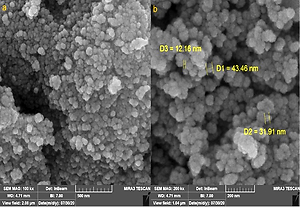Current issue
Archive
Manuscripts accepted
About the Journal
Editorial office
Editorial board
Section Editors
Abstracting and indexing
Subscription
Contact
Ethical standards and procedures
Most read articles
Instructions for authors
Article Processing Charge (APC)
Regulations of paying article processing charge (APC)
ONCOLOGY / RESEARCH PAPER
Novel Alhagi maurorum leaves mediated synthesis of titanium nanoparticles for human breast carcinoma applications: a preclinical trial
1
Nanjing Drum Tower Hospital Affiliated Hospital of Nanjing University, China
2
Kunshan Fourth People's Hospital, China
Submission date: 2021-03-03
Final revision date: 2021-03-13
Acceptance date: 2021-10-25
Online publication date: 2021-10-25
Corresponding author
KEYWORDS
Green synthesisTitanium nanoparticlesAlhagi maurorum leafChemical characterizationHuman breast cancer
TOPICS
ABSTRACT
Introduction:
In this study, titanium nanoparticles (TiNPs) were synthesized in an aqueous medium using Alhagi maurorum extract as stabilizing and reducing agents.
Material and methods:
Ultraviolet–visible spectrophotometry (UV-Vis), fourier-transform infrared spectroscopy (FTIR), X‐ray diffraction (XRD), scanning electron microscopy (SEM), and Energy Dispersive X-ray Spectrometry (EDS) were the techniques to characterize the biosynthetic of TiNPs. According to the XRD analysis. To survey the anti-human breast cancer effects of TiNPs, MTT assay was used on the common breast cancer cell lines i.e., breast cancer (Breast adenocarcinoma (MCF7), infiltrating ductal cell carcinoma (Hs 319.T), inflammatory carcinoma of the breast (UACC-732), and metastatic carcinoma (MDA-MB-453) cell lines.
Results:
16.08 nm was measured for TiNPs crystal size. SEM images exhibited a uniform spherical morphology in range size of 12.16 to 43.46 nm for the biosynthesized nanoparticles respectively. The cell viability of breast carcinoma cells decreased dose-dependently in the titanium nanoparticles presence. The IC50 of A. maurorum and titanium particles on MCF7 cell line were 680 and 359 µg/mL, on Hs 319.T cell line were 507 and 191 µg/mL, on UACC-732 cell line were 477 and 217 µg/mL, and on MDA-MB-453cell line were 507 and 191 µg/mL, respectively. TiNPs had high anti-breast cancer activities dose-dependently against MCF7, Hs 319.T, UACC-732, and MDA-MB-453 cell lines.
Conclusions:
The best result of anti-breast cancer effects was seen in the case of the Hs 319.T cell line.
In this study, titanium nanoparticles (TiNPs) were synthesized in an aqueous medium using Alhagi maurorum extract as stabilizing and reducing agents.
Material and methods:
Ultraviolet–visible spectrophotometry (UV-Vis), fourier-transform infrared spectroscopy (FTIR), X‐ray diffraction (XRD), scanning electron microscopy (SEM), and Energy Dispersive X-ray Spectrometry (EDS) were the techniques to characterize the biosynthetic of TiNPs. According to the XRD analysis. To survey the anti-human breast cancer effects of TiNPs, MTT assay was used on the common breast cancer cell lines i.e., breast cancer (Breast adenocarcinoma (MCF7), infiltrating ductal cell carcinoma (Hs 319.T), inflammatory carcinoma of the breast (UACC-732), and metastatic carcinoma (MDA-MB-453) cell lines.
Results:
16.08 nm was measured for TiNPs crystal size. SEM images exhibited a uniform spherical morphology in range size of 12.16 to 43.46 nm for the biosynthesized nanoparticles respectively. The cell viability of breast carcinoma cells decreased dose-dependently in the titanium nanoparticles presence. The IC50 of A. maurorum and titanium particles on MCF7 cell line were 680 and 359 µg/mL, on Hs 319.T cell line were 507 and 191 µg/mL, on UACC-732 cell line were 477 and 217 µg/mL, and on MDA-MB-453cell line were 507 and 191 µg/mL, respectively. TiNPs had high anti-breast cancer activities dose-dependently against MCF7, Hs 319.T, UACC-732, and MDA-MB-453 cell lines.
Conclusions:
The best result of anti-breast cancer effects was seen in the case of the Hs 319.T cell line.
We process personal data collected when visiting the website. The function of obtaining information about users and their behavior is carried out by voluntarily entered information in forms and saving cookies in end devices. Data, including cookies, are used to provide services, improve the user experience and to analyze the traffic in accordance with the Privacy policy. Data are also collected and processed by Google Analytics tool (more).
You can change cookies settings in your browser. Restricted use of cookies in the browser configuration may affect some functionalities of the website.
You can change cookies settings in your browser. Restricted use of cookies in the browser configuration may affect some functionalities of the website.



